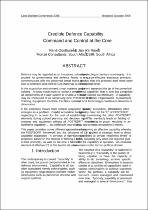JavaScript is disabled for your browser. Some features of this site may not work without it.
- ResearchSpace
- →
- Research Publications/Outputs
- →
- Conference Publications
- →
- View Item
| dc.contributor.author |
Oosthuizen, Rudolph

|
|
| dc.contributor.author |
Roodt, JHS

|
|
| dc.date.accessioned | 2009-03-09T08:44:57Z | |
| dc.date.available | 2009-03-09T08:44:57Z | |
| dc.date.issued | 2008-10 | |
| dc.identifier.citation | Oosthuizen, R and Roodt, JHS. 2008. Credible defence capability: command and control at the core. Land Warfare Conference, Brisbane, Australia, 27 - 31 October, pp 9. | en |
| dc.identifier.isbn | 0642705585 | |
| dc.identifier.uri | http://hdl.handle.net/10204/3167 | |
| dc.description | Land Warfare Conference, Brisbane, Australia, 27 - 31 October 2008 | en |
| dc.description.abstract | In the acquisition environment, smart systems and equipment represent the tip of the proverbial iceberg – it takes much more to realise a credible defence capability, that is, one that comprises all components of a user system to enable a mission to be carried out effectively. A capability may be conceived of as comprising nine POSTEDFIT (Personnel, Organisation, Sustainment, Training, Equipment, Doctrine, Facilities, Information and Technology) constituent elements or dimensions. If the emphasis moves from system acquisition to capability acquisition, affordability often emerges as a problem. Capital acquisition budgets typically cater for the “E” of POSTEDFIT, neglecting to account for the cost of establishing and maintaining the other POSTEDFIT elements during upfront planning and decision making. This inevitably leads to fielding of systems and equipment without all POSTEDFIT elements being in place, resulting in an ineffective capability an ineffective insurance policy and a waste of taxpayer’s money. This paper considers some different approaches toward ensuring an effective capability whereby the POSTEDFIT framework and the principles of C2 are applied at strategic level to direct capability acquisition. A concept of maintaining capabilities at certain “readiness levels” is proposed, based on the premise of fielding a fully ready capability only when it is required (justin-time principle), as well as the time it takes to field the capability in question. An essential element of effective C2 at this level is situation awareness in the techno-political domain | en |
| dc.language.iso | en | en |
| dc.subject | Command control | en |
| dc.subject | Defence capability | en |
| dc.subject | Cynefin | en |
| dc.subject | Capability life cycle | en |
| dc.title | Credible defence capability: command and control at the core | en |
| dc.type | Conference Presentation | en |
| dc.identifier.apacitation | Oosthuizen, R., & Roodt, J. (2008). Credible defence capability: command and control at the core. http://hdl.handle.net/10204/3167 | en_ZA |
| dc.identifier.chicagocitation | Oosthuizen, Rudolph, and JHS Roodt. "Credible defence capability: command and control at the core." (2008): http://hdl.handle.net/10204/3167 | en_ZA |
| dc.identifier.vancouvercitation | Oosthuizen R, Roodt J, Credible defence capability: command and control at the core; 2008. http://hdl.handle.net/10204/3167 . | en_ZA |
| dc.identifier.ris | TY - Conference Presentation AU - Oosthuizen, Rudolph AU - Roodt, JHS AB - In the acquisition environment, smart systems and equipment represent the tip of the proverbial iceberg – it takes much more to realise a credible defence capability, that is, one that comprises all components of a user system to enable a mission to be carried out effectively. A capability may be conceived of as comprising nine POSTEDFIT (Personnel, Organisation, Sustainment, Training, Equipment, Doctrine, Facilities, Information and Technology) constituent elements or dimensions. If the emphasis moves from system acquisition to capability acquisition, affordability often emerges as a problem. Capital acquisition budgets typically cater for the “E” of POSTEDFIT, neglecting to account for the cost of establishing and maintaining the other POSTEDFIT elements during upfront planning and decision making. This inevitably leads to fielding of systems and equipment without all POSTEDFIT elements being in place, resulting in an ineffective capability an ineffective insurance policy and a waste of taxpayer’s money. This paper considers some different approaches toward ensuring an effective capability whereby the POSTEDFIT framework and the principles of C2 are applied at strategic level to direct capability acquisition. A concept of maintaining capabilities at certain “readiness levels” is proposed, based on the premise of fielding a fully ready capability only when it is required (justin-time principle), as well as the time it takes to field the capability in question. An essential element of effective C2 at this level is situation awareness in the techno-political domain DA - 2008-10 DB - ResearchSpace DP - CSIR KW - Command control KW - Defence capability KW - Cynefin KW - Capability life cycle LK - https://researchspace.csir.co.za PY - 2008 SM - 0642705585 T1 - Credible defence capability: command and control at the core TI - Credible defence capability: command and control at the core UR - http://hdl.handle.net/10204/3167 ER - | en_ZA |






